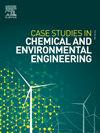The thermal-flow performance of water-Al2O3 nanofluid flow in an elliptical duct heat exchanger equipped with two rotating twisted tapes
Q1 Environmental Science
Case Studies in Chemical and Environmental Engineering
Pub Date : 2025-01-03
DOI:10.1016/j.cscee.2025.101094
引用次数: 0
Abstract
Background
The thermal-flow performance of nanofluid (NF) flow in an elliptical duct heat exchanger fitted and turbulated with two rotating tapes is investigated. The issues concerning rotating twisted tapes inside the oval tubes using NF as the working fluid simulated with two-phase modeling have received less attention in previous studies.
Methods
Considering the importance of employing the heat transfer improving methods in tubular heat exchangers, the passive and ative heat transfer improving methods examined here. As a novel study case, the rotated tapes beside the water-Al2O3 NF of was used; and sensitivity analysis was performed to reveal the effect of the volume fraction of nanoparticles (ϕ), tapes rotational speed and Re number on the Nu number, pumping power and figure of merit (FOM). The heat flux of 5000 Wm−2 was applied to the wall surface, and the two-phase mixture method was employed for the simulation. The heat exchanger performance is studied in cases of fixed and rotating twisted tapes with three different rotational speeds. The results show that increasing the Re number, ϕ and the rotation speed of the blades would increase the Nu number and pumping power in all cases. The increase in ϕ improves the Nu number by 6.1 %–19.4 % and the pumping power by 59.2–280 %. The Nu number change by increasing ϕ is lower at low Re numbers and becomes higher at high Re numbers. The effect of ϕ increment on heat transfer is increasing but took place with a higher inclination rate in rotating tapes rather than stationary tapes and plain tube cases. In the cases of rotated twisted tape mode, the value of FOM is always greater than one and is below 0.9 for stationary mode.
Significant findings
The highest value of FOM is 1.57, which is for the highest rotational speeds, the lowest Re number, and ϕ = 1 %. Increasing the Re number reduces the FOM while increasing ϕ improves it.
Practical significance and potential area of application
The increasing need for efficient heat transfer in heat exchanger devices necessitated the application of heat transfer augmentation techniques. The effects of twisted tapes, their rotation, and the application of NFs in heat exchangers as the active and passive heat transfer increment methods are studied numerically.
水- al2o3纳米流体在装有两根旋转扭带的椭圆管换热器中的热流性能
研究了纳米流体在装有两个旋转带的椭圆管式换热器内的热流特性。在以往的研究中,用两相模型模拟以NF为工质的椭圆管内旋转扭带的问题较少受到关注。方法考虑到在管式换热器中采用换热改进方法的重要性,对被动换热和主动换热进行了研究。作为一种新颖的研究案例,在水- al2o3 NF的旁边使用了旋转带;灵敏度分析揭示了纳米颗粒体积分数(φ)、胶带转速和Re数对Nu数、泵送功率和优值图(FOM)的影响。在壁面施加5000 Wm−2的热流密度,采用两相混合法进行模拟。研究了三种不同转速下固定和旋转扭带换热器的性能。结果表明,在所有情况下,增加叶片的Re数、φ和转速都会增加Nu数和泵送功率。φ的增加使Nu数提高了6.1% ~ 19.4%,泵送功率提高了59.2% ~ 280%。随着φ的增加,Nu数的变化在低Re数时较低,在高Re数时变高。φ增量对传热的影响正在增加,但在旋转磁带而不是固定磁带和普通管情况下,倾角率更高。在旋转扭带模式下,FOM的值总是大于1,而在静止模式下,FOM的值小于0.9。重要发现FOM的最大值为1.57,这是最高的转速,最低的Re数,和φ = 1%。增加Re数可减小FOM,而增加ϕ可改善FOM。实际意义和潜在应用领域对换热器高效传热的要求日益提高,需要应用换热强化技术。通过数值模拟研究了螺旋带、螺旋带的旋转以及螺旋带在换热器中作为主动和被动换热增量方式的应用。
本文章由计算机程序翻译,如有差异,请以英文原文为准。
求助全文
约1分钟内获得全文
求助全文
来源期刊

Case Studies in Chemical and Environmental Engineering
Engineering-Engineering (miscellaneous)
CiteScore
9.20
自引率
0.00%
发文量
103
审稿时长
40 days
 求助内容:
求助内容: 应助结果提醒方式:
应助结果提醒方式:


